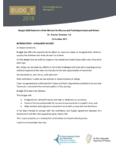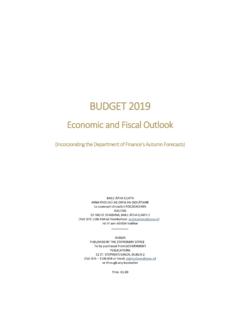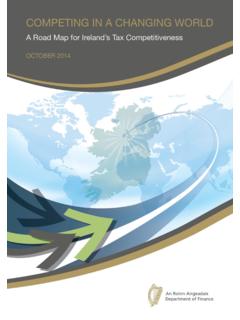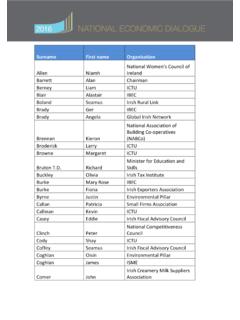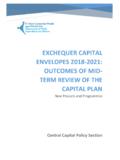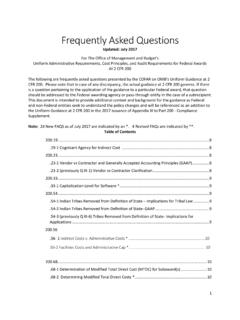Transcription of Budget Book 2017
1 Budget 2018 Economic and Fiscal Outlook (Incorporating the Department of Finance s Autumn Forecasts) BAILE THA CLIATH ARNA FHOILSI AG OIFIG AN tSOL THAIR Le ceannach d reach FOILSEACH IN RIALTAIS 52 FAICHE STIABHNA, BAILE THA CLIATH D02DR67 (Teil: 01 6476834 n 1890 213434; Fax 01 6476843) n tr aon d olt ir leabhar DUBLIN PUBLISHED BY THE STATIONERY OFFICE To be purchased from GOVERNMENT PUBLICATIONS 52 ST. STEPHEN'S GREEN, DUBLIN D02DR67 (Tel: 01 6476834 or 1890 213434; Fax: 01 6476843) or through any bookseller Price Department of Finance | Macroeconomic and fiscal outlook Page | i Budget 2018 ECONOMIC AND FISCAL OUTLOOK (INCORPORATING THE DEPARTMENT OF FINANCE S AUTUMN FORECASTS) Page Contents i Tables, figures, annexes and boxes ii 1. Overview and General Policy Strategy 1 Policy Strategy 1 Short-term Economic and Budgetary Outlook 2 2.
2 Economic Outlook 5 Summary 5 Macroeconomic Outturn 2017 5 Macroeconomic Projections 2018 5 Balance of Payments 9 The Labour Market 9 Price Developments 10 Medium-Term Growth Prospects 2019-2021 11 Comparison of Forecasts 12 3. Exchequer Developments and Outlook 15 Summary 15 Exchequer Outturn 2017 15 Exchequer Outlook 2018 18 Fiscal Outlook 2019-2021 19 4. General Government Developments and Outlook 23 Summary 23 General Government Balance in 2017 23 General Government Balance in 2018 Structural Budget Balance 24 25 Comparison of Forecasts 25 5. General Government Debt 27 Summary 27 Debt Developments Funding Developments 27 30 Comparison of Forecasts 31 6. Risks and Sensitivity Analysis 33 Summary 33 Risks to the Economic and Fiscal Forecasts 33 Sensitivity Analysis 34 Contingent Liabilities 35 7. Budgetary Reform 39 Summary 39 Forthcoming Budgetary Reform 39 Department of Finance | Macroeconomic and fiscal outlook Page | ii Tables, Figures, Boxes and Annexes Tables Table 1 Summary table main economic and fiscal variables 2 Table 2 External assumptions 6 Table 3 Macroeconomic prospects 7 Table 4 Savings.
3 Investment and the Balance of Payments 9 Table 5 Labour market prospects 10 Table 6 Price developments 11 Table 7 Range of forecasts 12 Table 8 Table 9 Table 10 Table 11 Table 12 Exchequer balance 2017 - 2021 The Impact of Budget 2018 on the Fiscal Position in 2018 Alternative Presentation of Exchequer Position Exchequer balance to GGB 2016 - 2021 Estimate of local government income and expenditure 2018 16 20 21 23 24 Table 13 Structural Budget balance 25 Table 14 Table 15 Comparison of Budgetary Forecasts General Government Debt Developments 26 29 Table 16 Gross and Net General Government Debt 29 Table 17 Irish Sovereign Credit Ratings 30 Table 18 Table 19 Table 20 Table 21 Sensitivity Analysis Contingent Liabilities Macro-economic Risk Assessment Matrix Fiscal Risk Assessment Matrix 34 35 37 38 Table 22 Table 23 Macroeconomic Developments Price Developments 42 42 Table 24 Labour Market Developments 43 Table 25 Sectoral Balances 43 Table A1 Difference between Exchequer Balance and GG Balance 44 Table A2 General government balance 2016-2021 45 Table A3 Comparison of Vintages of Receipts and Expenditures for 2017 46 Table A4 General government interest expenditure 2016-2021 47 Table A5 Projected movement in general government debt 2016-2021 47 Table A6 Breakdown of revenue 47 Table A7 Expenditure developments 48 Table A8 Application of Expenditure Benchmark 48 Department of Finance | Macroeconomic and fiscal outlook Page | iii Tables, Figures, Boxes and Annexes (continued)
4 Figures1 Figure 1 Change in external assumptions relative to spring forecasts 6 Figure 2 Figure 3 Employment and the Phillips Curve Comparison of autumn and spring 2017 GDP forecast 10 13 Figure 4 End September Cumulative Tax Receipts Relative to Profile 15 Figure 5 Comparison of autumn and spring 2017 GG deficit forecast 26 Figure 6 General government debt-to-GDP and debt-to-GNI*, per cent 27 Figure 7 Debt interest to revenue ratio, per cent 28 Figure 8 Maturity profile of long-term marketable and official debt. 31 Figure 9 Comparison of autumn and spring 2017 GG debt forecast 32 Figure 10 Fan chart of Real GDP, per cent change 33 Boxes Box 1 Box 2 Revisions to the Quarterly National Accounts Forecasting in-year Corporation Tax Receipts 8 17 Annexes Annex 1 IFAC Endorsement of the Macroeconomic Forecast 41 Annex 2 Additional Fiscal Statistics and Tables 44 Annex 3 Macro-Economic aggregates 2016 to 2021 49 1 In line with the Governments Open Data Initiative the data underpinning charts in this document are available on the Department of Finance website.
5 Department of Finance | Macroeconomic and fiscal outlook Page | 1 Chapter 1 Overview and General Policy Strategy Policy Strategy A decade ago, the first tremors of the global financial crisis were being felt. What ultimately transpired was the deepest global recession in decades and the fall-out was severe, especially for the Irish economy which in tandem suffered its own, self-inflicted wound. Decisive policy action in the intervening period has put the Irish public finances on a more sustainable footing and the medium term budgetary objective (MTO) of a balanced Budget is now within sight; on the basis of the projections set out in this document, the MTO will be achieved next year. Notwithstanding significant progress in recent years, many of the scars of the crisis remain, including a high level of public debt. The lesson is clear: policy must ensure that the mistakes of the past are not repeated.
6 To this end, the Government will balance the books next year as well as maintain the debt ratio on a downward trajectory, both of which are crucial for continued, sustainable improvements in our living standards. In the decade since the crisis began, the scale of global economic as well as social and political change has been enormous. To navigate our economy successfully through these ongoing changes, it is imperative that sensible, sustainable and prudent policies continue to be implemented domestically. A key part of this is ensuring that the economy is sufficiently flexible so that it can adapt rapidly to changes in the external environment. Recovery from the crisis has been underway, in earnest, since around 2013 with the economic cycle now entering a more mature phase. Indeed, the more-rapid-than-assumed pace of recovery means that capacity constraints are becoming increasingly binding.
7 The unemployment rate, perhaps the best indicator of slack in the economy, continues to fall and, while not there yet, the economy is approaching full-employment. In these circumstances, it is crucial that budgetary policy is not used in a manner that over-heats the economy. In the Budget for next year, the Government is implementing sensible budgetary policies designed to address key priority areas while, at the same time, ensuring that the economy can absorb the increased outlays without adding to inflationary pressures. For instance, current expenditure next year will grow at a rate that is below the real growth rate of the economy. Increases in public spending are being targeted towards those areas where social and economic needs are greatest capital spending, for example, will increase by around 17 per cent next year in order to address infrastructural constraints.
8 But it is also important to focus on the totality of public spending and not just the incremental amount. Next year total spending will amount to around 61 billion and it is imperative that these taxpayer funds are allocated in a manner which ensures value-for-money. The labour market is perhaps the best barometer of economic developments at present, given the many distortions in the headline GDP and GNP indicators, and a key priority for the Government is to ensure an environment that is supportive of job creation. To this end, the Government will continue to reform the income taxation system in order to ensure that work pays. The Government s approach, which is focussed on low- and middle-income earners, is to ensure steady and sustainable progress in reducing the income tax burden in the years ahead. Ensuring competitiveness is also a key priority for Government.
9 Providing certainty, including with respect to the future evolution of the public finances, is important to support investment and job creation. This is why the Government is providing for a 10-year capital plan to address bottlenecks and promote balanced regional growth. This will allow businesses and families plan for the future Department of Finance | Macroeconomic and fiscal outlook Page | 2 with greater certainty. Moreover, measures announced in the Budget designed to support the provision of finance to the residential construction sector will help to address housing supply shortages and, in doing so, support further competitiveness improvements. While short-term prospects internationally have generally improved since the spring with the notable exception of the UK the evolution of both external demand and international policies remains uncertain.
10 For instance, notwithstanding the possibility of a pause in the UK s exit from the European Union until 2021, the manner of the UK s exit remains unclear; the actual post-exit arrangements will have a major bearing on economic prospects for Ireland (as has been highlighted in several Department of Finance publications). There is also considerable uncertainty attached to potential corporation tax changes in some regions. On a more positive note, the prospect of de-globalisation and more protectionism appears to have receded somewhat. Given the prevailing levels of uncertainty, a key policy priority is to re-build our safety buffers so that the economy can withstand any deterioration in the external environment. This means ensuring a sustainable evolution of costs, including by continuing to promote and support productivity growth, as well as ensuring steady progress in reducing public indebtedness.
